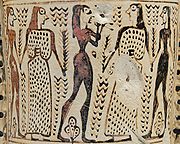
Analatos Painter
Encyclopedia


Attica
Attica is a historical region of Greece, containing Athens, the current capital of Greece. The historical region is centered on the Attic peninsula, which projects into the Aegean Sea...
vase painter of the Early Proto-Attic style.
The true name of the Analatos Painter is unknown. His conventional name is derived from the central Attic area of Analatos (where today is built Nea Smyrni
Nea Smyrni
Nea Smyrni is a southern suburb of Athens, Greece. Nea Smyrni is located about 5 km SW of downtown Athens, about 5 km SW of Kifissias Avenue, W of Vouliagmenis Avenue, about 6 km E of Piraeus, and NE of Poseidonos Avenue....
), where several of his works have been excavated. His name vase
Name vase
In classical archaeology, a name vase is a specific "vase" whose painter's name is unknown but whose workshop style has been identified. The painter is conventionally named after the selected "name vase" that embodies his characteristic style, or for one of its distinctive painted subjects, or for...
is a hydria
Hydria
A hydria is a type of Greek pottery used for carrying water. The hydria has three handles. Two horizontal handles on either side of the body of the pot were used for lifting and carrying the pot. The third handle, a vertical one, located in the center of the other two handles, was used when...
. He belongs to the transition from Late Geometric to Early Proto-Attic vase painting. He is thought to have been a pupil of the Late Geometric Statathou Painter. The earliest works ascribed to him are still within a clear Late Geometric tradition. For example, one of his Geometric hydria
Hydria
A hydria is a type of Greek pottery used for carrying water. The hydria has three handles. Two horizontal handles on either side of the body of the pot were used for lifting and carrying the pot. The third handle, a vertical one, located in the center of the other two handles, was used when...
i depicts a prothesis (laying-out of a body), showing Egyptian influences. The adoption of eastern influences was a key feature of the subsequent Orientalising Period
Orientalizing Period
In the history of ancient Greece, the Orientalizing period is the cultural and art historical period informed by the art of Anatolia, Syria, Assyria, Phoenicia and Egypt, which started during the later part of the 7th century BCE. It encompasses a new, Orientalizing style, spurred by a period of...
, of which the Analatos Painter was one of the main early proponents. Characteristic of this new style were fantastic animals, sphinx
Sphinx
A sphinx is a mythical creature with a lion's body and a human head or a cat head.The sphinx, in Greek tradition, has the haunches of a lion, the wings of a great bird, and the face of a woman. She is mythicised as treacherous and merciless...
es without wings or faces, rows of dancing men or women, cable patterns and rosettes. His oldest known amphora
Amphora
An amphora is a type of vase-shaped, usually ceramic container with two handles and a long neck narrower than the body...
, now in Oxford
Oxford
The city of Oxford is the county town of Oxfordshire, England. The city, made prominent by its medieval university, has a population of just under 165,000, with 153,900 living within the district boundary. It lies about 50 miles north-west of London. The rivers Cherwell and Thames run through...
(Ashmolean Museum
Ashmolean Museum
The Ashmolean Museum on Beaumont Street, Oxford, England, is the world's first university museum...
) shows a row of two-horsed chariots on its belly, as does a loutrophoros
Loutrophoros
A loutrophoros is a distinctive type of Greek pottery vessel characterized by an elongated neck with two handles. The loutrophoros was used to hold water during marriage and funeral rituals, and was placed in the tombs of the unmarried...
in the Louvre
Louvre
The Musée du Louvre – in English, the Louvre Museum or simply the Louvre – is one of the world's largest museums, the most visited art museum in the world and a historic monument. A central landmark of Paris, it is located on the Right Bank of the Seine in the 1st arrondissement...
and several other pieces. In the execution of detail, he frequently followed older precepts. His period of activity is estimated to be similar to that of the Mesogeia Painter
Mesogeia Painter
The Mesogeia Painter, also Mesogaia Painter, was an Early Proto-Attic vase painter.His conventional name is derived from his name vases, several hydriai decorated by him and discovered in the Mesogeia. This Early Proto-Attic artist was a contemporary of the Analatos Painter, active in the first...
, between circa 700 and 675 BC. Besides amphorai and hydriai, he also painted krater
Krater
A krater was a large vase used to mix wine and water in Ancient Greece.-Form and function:...
s, bowls and lids. A votive plaque attributed to him bears the inscription ΣΟΝΟΣΈΠΙΣΤ (sonos epist), indicating that he was literate. Additionally, it is the oldest known painted inscription in Greek. It is possible that the Analatos Painter was also a potter.
Literature
- John BoardmanJohn BoardmanJack Melton Boardman, commonly known as John Boardman, is an American former professor of physics at Brooklyn College.- Academic career :...
: Early Greek Vase Painting. 11th to 6th Century BC. A Handbook, Thames and Hudson, London 1998 (World of Art), 89 ISBN 0-500-20309-1 - Thomas Mannack: Griechische Vasenmalerei. Eine Einführung. Theiss, Stuttgart 2002, p. 95f. ISBN 3-8062-1743-2.

